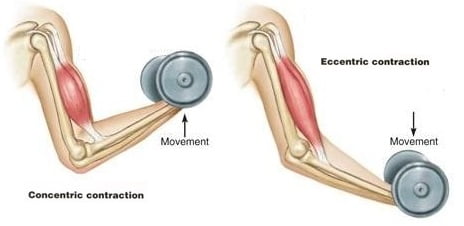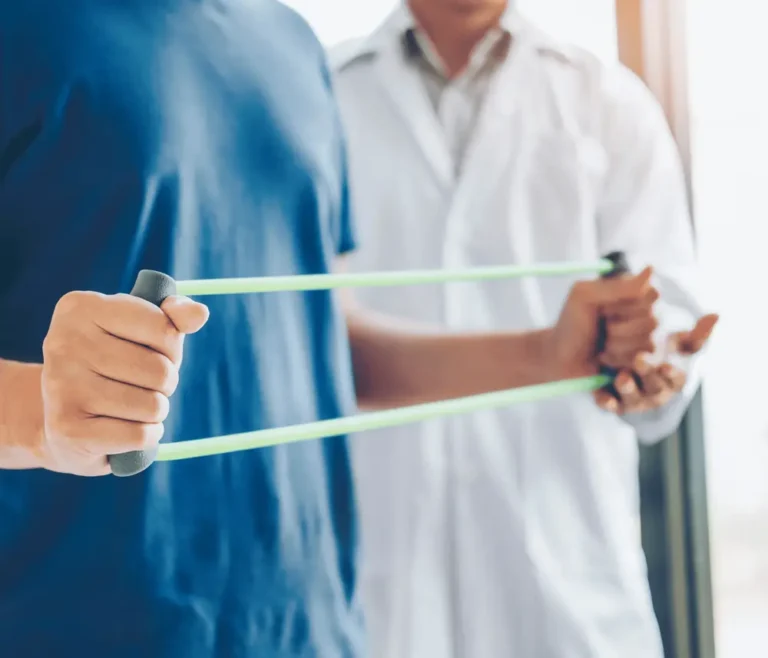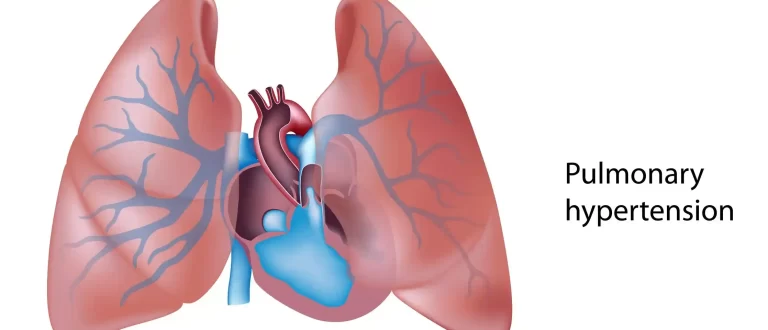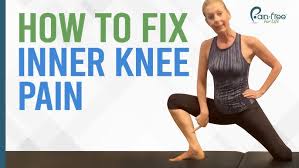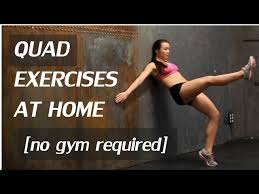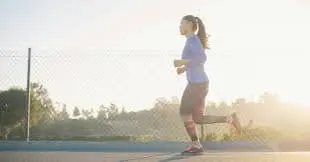Eccentric Exercise
What is Eccentric strength training?
Eccentric exercise refers to a type of muscle contraction where the muscle lengthens while under tension, typically during the lowering phase of a movement. Unlike concentric exercises, where muscles shorten as they contract, eccentric exercises focus on the controlled elongation of muscles, making them highly effective for building strength, improving muscle control, and enhancing flexibility.
This method is widely used in rehabilitation and athletic training due to its ability to target muscle endurance and recovery. Eccentric exercises are particularly beneficial for injury prevention and rehabilitation, especially in conditions like tendonitis or after muscle strain.
Individuals who want to recover particular muscles and tendons, the elderly, and athletes participating in professional and leisure sports can all benefit from eccentric exercise.
This later part of the action is the subject of eccentric training, which increases difficulty by decreasing the eccentric phase’s cadence, or speed. Less force than gravitational pull is required to move the weight during the eccentric part of the cycle. For this reason, eccentric exercise is frequently called “negative” repetitions in training.
Physiological mechanisms
The minuscule contractile units, sarcomeres, comprise the “tension-producing tissue” found in muscles.
Actin is dragged across myosin during a concentric exercise by the periodic union and disassociation of myosin and actin cross-bridges, causing a muscle to shorten. To connect and disconnect, the cross-bridge requires splitting one adenosine triphosphate (ATP) molecule. Two such workouts include lifting weights and kicking a ball.
In controlled release reversals of such concentric motions, the eccentric action strains the muscle with an opposing force greater than the muscular force. When the muscle fiber’s myofilaments are stretched during such eccentric contractions, there could be fewer cross-bridge myosin and actin detachments. The muscle contracts more forcefully the more cross-bridges there are joining. Walking up an incline or lowering a heavy object against gravity are two exercises that include eccentric muscular activation.
Exercise-induced sarcomere stretching, or delayed onset muscle soreness (DOMS), is a condition in which eccentric motions stretch the sarcomeres to the point that the myofilaments are strained. To improve strength and allow the strain (in response to a certain force level) to decrease over time, the exerciser would eccentrically stimulate the muscle and then repeat at weekly intervals. This would hasten recovery from the eccentric activity and assist prevent or reducing DOMS.
Eccentric exercises
These days, resistance training, also known as eccentric exercise, is used to heal sports injuries and provide older people with Geriatric Diseases, neurological diseases, and cardiovascular issues.
Muscle loss is a common occurrence for such individuals, and many find it difficult to stick to rigorous workout schedules. Eccentric muscle contractions provide significant forces with minimal energy usage. According to Hortobágyi, eccentric exercise has the most potential for muscular growth because of these qualities. To become stronger, muscles must be overcome by an outside force as they elongate. Eccentric contraction is fundamentally the concept that characterizes muscle strengthening.
Eccentric contractions are limited since they can cause harm and damage to the muscles. Even while an eccentric contraction doesn’t harm or injure the muscle, it might progressively induce discomfort in the affected area.
Proof of muscle growth without harm
One recurring problem in ACL healing is building up quadriceps strength without reinjury. It is possible to increase muscle strength and volume with early, high-force eccentric training without damaging the surrounding soft tissue, the articular cartilage, or the ACL graft. Twenty sessions of low-intensity eccentric training on a treadmill resulted in a substantial increase in the wet weight of the muscles and the fiber cross-section of the rat muscles compared to the control and level groups. Low-intensity eccentric contractions may “cause enough mechanical stress to create muscle growth without over-stressing, which could induce muscle fiber damage,” according to the conclusions drawn from this data.
According to other studies, hypertrophy can occur without causing injury to the muscles. People who perform eccentric training undergo hypertrophy because eccentric contractions increase mechanical stress. Studies on older volunteers have shown that low-intensity eccentric exercise helps minimize muscular damage. Seniors should engage in low-intensity eccentric activity since it requires less energy and oxygen.
Oxygen consumption and eccentric contraction:
- For muscles to work correctly, they need oxygen. This kind of muscle activity is known as negative work since the muscle is contracting eccentrically against resistance. When the force applied to a muscle is larger than the force that caused it, it absorbs mechanical energy.. known as negative work. An experiment was conducted on bicycles. Measured oxygen consumption occurred during “positive work,” or cycling forward, and “negative work,” or pedaling against resistance.
- With a ratio of 3:7 for oxygen consumption, negative effort required less oxygen than positive activity. Because eccentric activity uses less oxygen, research has been done on those with severe COPD. Following an eccentric cycling exercise program, the patients showed high compliance, little muscle soreness that did not influence power, and no harmful side effects. Eccentric cycling was found to be a safe alternative for COPD patients by other cycling research because it allows them to perform high-intensity labor at a lower cost.
Eccentric exercise and cardiac output:
- With oxygen becoming less expensive, what effect may eccentric exercise have on the heart?
The impact of concentric and eccentric cardiac contractions on cardiac autonomic regulation was investigated following exercise. The findings indicated that resistance training—specifically, eccentric contractions—facilitated the development of strength. It was also shown that there was an increase in cardiac vagal modulation during recovery.
The argument that eccentric exercise is preferable to concentric exercise for training and rehabilitation reasons has a lot of evidence to back it up in terms of power, energy cost, oxygen usage, and muscle building.
Benefits of eccentric strength training
Eccentric training is a potent training technique utilized by athletes, bodybuilders, and physical therapists because of its many muscle-building benefits.
The key advantages of eccentric training are outlined below:
Allows for training at a higher level
Supramaximal training is the process of completing an activity with resistance that is somewhat greater than what a particular muscle can endure on its own.
Research on eccentric training shows that our muscles are stronger while doing an eccentric contraction as opposed to a concentric contraction. Because of this, eccentric exercise enables you to apply more weight to the muscle than you could with traditional training.
The use of supramaximal eccentric loading on the leg press was found to boost force output and movement velocities in a 2018 study including fifteen young males. Sports that need an explosive element, such as volleyball, basketball, jogging, and soccer, may go well with these effects.
To avoid harm, it’s important to remember that this training method is most effective for those with at least a few months of training experience.
More effectiveness when moving
Eccentric movements are uncommon because they need the same amount of force as concentric motions but require less energy and muscle work.
Moreover, eccentric muscle contractions need just around 25% of the energy used by concentric muscle contractions, while having the same or greater potential for producing muscular force. Titin, an elastic molecule found in muscles that inhibits them from stretching and opposes them from uncoiling like a spring, is thought to be the cause of this. Your muscles may effectively “put on the brakes” thanks to this mechanism.
Given that eccentric training yields superior results without using as much energy as concentric contractions, it could be a better option for strength training. This is the reason it’s a popular choice in rehabilitation and sports training environments. When done correctly, eccentric exercise may give a greater stimulus in a shorter amount of time, making it a particularly beneficial tool for persons with limited time.
Greater hypertrophy of the muscles
Since it has been shown that eccentric movements place greater stress on the muscle than concentric ones, it has been theorized that including eccentric-focused sessions in your training regimen may promote muscular hypertrophy (growth).
Concentric training in healthy individuals following a resistance training regimen. Overall, the study found that compared to concentric exercise (6.8%), eccentric training produced somewhat higher muscle growth (10%).
This is thought to be because somewhat higher muscle damage from eccentric exercise results in a greater increase in muscle protein synthesis, which is essential for muscular growth. Though training with an eccentric focus may be somewhat more successful in promoting muscular growth, it’s important to include both concentric and eccentric muscle contractions for the best results.
Strength training eccentrically versus concentrically
During eccentric and concentric training, emphasis is concentrated on two diametrically opposite types of muscle contractions. The muscle tightens during concentric contractions to overcome the resistance, and then it stabilizes during the contraction.
Conversely, during eccentric contractions, the muscle lengthens when the resistance rises above the muscle’s capacity to produce force.
During strength training exercises, a certain muscle is frequently contracted both concentrically and eccentrically. Moreover, on the opposing side of the joint, the antagonist, or opposing muscle, contracts eccentrically while the agonist muscle contracts concentrically.
For example, in a typical bicep curl, your biceps contract eccentrically as you return the weight to your side and contract upwards throughout the curling motion. During the concentric part of the exercise, the biceps shorten while the triceps extend and contract eccentrically.
As such, every strength training regimen you follow will involve both eccentric and concentric muscle contractions.
However, traditional strength training routines usually emphasize the concentric part of the motion. A training regimen that prioritizes eccentric strength will frequently slow down the exercise’s eccentric phase to highlight that particular element.
How do eccentric training methods fit into physical therapy and rehabilitation?
Physical therapists and other rehabilitation specialists still use eccentric exercise as part of their toolset. This is understandable given that eccentric exercise has been shown to hasten the recovery from several musculoskeletal disorders.
Could aid in knee recovery
Eccentric training is a common tool used by physical therapists to aid patients in their recovery following knee surgery or injury. According to a study, performing eccentric workouts after knee surgery may assist build muscles and connective tissue while also improving knee stability and have no discernible negative consequences.
May provide enhanced neuromuscular control
Eccentric exercise has also been shown to improve neuromuscular control following an injury, strengthening the connection between your brain and the injured muscle. This could be crucial to the healing process since studies have demonstrated that the brain changes following trauma.
It can aid in maintaining muscular mass
Particularly in the elderly population, eccentric exercise has been shown to help preserve and even increase muscle mass when included in a carefully thought-out rehabilitation program.
This is explained by the ability of eccentric training to provide great force production with little energy expenditure. That being said, this group is more susceptible to the inflammation that results from muscle damage caused by exercise.
To optimize results while limiting negative effects, rehabilitation professionals usually maintain loads and intensities at a modest level.
How often should eccentric training be performed?
Eccentric-focused workouts are often part of a well-rounded strength training program that incorporates other training methods. It is typical to perform eccentric training two to four times a week, depending on your degree of proficiency.
In rehabilitation settings, eccentric training sessions could be conducted a bit more often to encourage the regeneration of muscle and connective tissue and to improve mobility. Nevertheless, to avoid further damage, the intensity is frequently reduced.
It’s advisable to do a few eccentric-focused exercises at the conclusion of your regular training program when you first start, just so you can have a feel for them. Following that, you might up the ante and incorporate them into your regular training routines many times a week.
Exercises for a programme of eccentric training
Your sport, skill level, and goals will significantly impact your eccentric exercise program.
You might want to consult a qualified physical therapist or trainer for more expert guidance.
Try these well-liked eccentric exercises as a starting point. For every one of these exercises, try to keep the eccentric portion to a slow count of five. Then change the count to make it more difficult or easy.
Hamstring rollouts with a physioball eccentrically
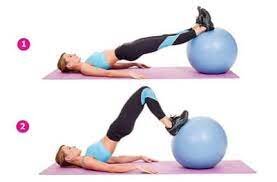
- Raise your butt slightly off the floor by stretching your legs and placing both of your feet on the physioball.
- To return the ball to the starting position, slowly extend your legs while focusing on eccentrically contracting your hamstrings.
- Then alternate sides once more.
- Use one leg raised in the air and the other on a ball to complete the eccentric leg extension exercise, which will intensify your workout.
Eccentric hamstring curl

- Throughout this exercise, you will curl the weight with both legs. To increase the eccentric power, you will then gently return the weight to the starting position with one leg.
- You may do this exercise by sitting or lying down and curling your hamstrings.
- The rear of your calves should rest against the pad while you sit or lie in a hamstring curling position.
- Opt for a slightly lower weight than you usually use for leg curls.
- Curl the weight with both legs by tensing your hamstrings until the pad hits the back of your upper thighs.
- Take one leg off the cushion.
- For the needed number of reps and sets, continue lowering the weight with the opposite leg on the next rep.
Barbell squats
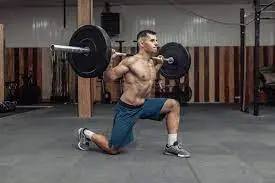
- You may also perform this exercise without any weight if you’re not experienced with eccentric training.
- Place a barbell on a squat rack that is the appropriate weight; this weight is frequently far less than what you would use for regular squats.
- To make the bar heavier, place it on your back. Next, adopt a posture where your feet are wider apart than shoulder-width apart.
- As you progressively descend, kneel, apply pressure to the weight on the bar, and count to three.
- At the bottom of each rep, pause for a short while before pushing through the floor to go back to the starting position.
- Proceed with the previous stages, being careful to reduce progressively each time.
Eccentric box step-downs

- To make the eccentric portion of this workout more intense, step up onto a box with one leg and then slowly step off the box with the other leg.
- You may finish them with a shorter box or without any weights to make things easier.
- Step forward in front of a step-up box holding a dumbbell in each hand that is the appropriate size.. A smaller box and fewer weights are a good starting point for beginners.
- Feel your quadriceps contract eccentrically as you cautiously step down from the box with your left leg once you’ve reached the top and gained stability.
Pull-ups with a band–Eccentrically

- To maximize muscle activation and intensity, slow down the descent phase of a standard pull-up when executing this exercise.
- Position yourself in front of a pull-up bar that has a long resistance band tied firmly across the middle.
- Step forward slowly or lunge to grab the bar that is broader than your shoulder. Step with one or both feet to enter the band.
- Rise to the occasion with the band’s help. As you gently descend to the beginning position, your back muscles should begin to strain. First, maintain your head slightly above the bar to stabilize at the top.
Eccentric seated cable row

- In this sitting cable row variation, you may put more strain on your back muscles by slowing down the eccentric phase.
- When loading a seated cable row machine, use somewhat less weight than normal.
- Hold on to the grips or bar as you sit down.
- Maintain a straight torso while you row the weight back until the grips or bar nearly touches your lower sternum.
- When you feel your lats contract eccentrically, carefully reverse the movement and return the weight to the beginning position.
Dumbbell curl
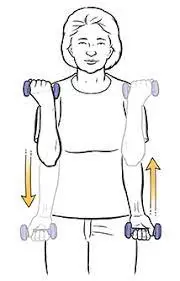
- A dumbbell that is somewhat lighter than the one you would normally use for a dumbbell curl is what you should use.
- Holding both dumbbells at your sides, take a small break at the top as you curl them both up at the same time. An alternative method of doing this movement is to curl up one arm at a time in alternation.
- As you slowly move the weights back to the beginning position, feel your biceps contract eccentrically.
- Repeat this exercise for the desired amount of repetitions and sets.
Typical mistakes and considerations when engaging in eccentric exercise
Eccentric training may appear like a fairly simple exercise, but mistakes can still be made, especially in the beginning.
The following list of common mistakes along with advice on how to prevent them:
Using a very hefty weight
Selecting the appropriate weight is essential, even if the eccentric portion of an exercise program strengthens the muscles.
You run the danger of straining a muscle or connective tissue when you apply too much resistance during eccentric movement. An overuse of weight that results in a proper breakdown might also lessen the workout’s effectiveness.
Risks Associated With Eccentric Exercise
Every kind of training has its risks. After onset, DOMS frequently appears 12 to 24 hours later and goes away 5 to 7 days later.
The effects of eccentric exercise on your muscles will vary based on your level of intensity. It’s crucial to remember that tiny microtears in the muscles are advantageous: according to Pedemonte, “that’s what’s been shown to create a stimulus for muscle growth.”
Walking, swimming, or yoga are excellent forms of active recuperation since your muscles are weaker and more prone to damage throughout the healing process.
Remember that lifting too much weight too quickly might cause strains (stretching or ripping a tendon) or sprains (stretching or tearing a ligament) since eccentric exercise enables your body to handle more weight. According to Guglielmo, you run the danger of lowering too quickly and ripping or pulling something when performing an eccentric pull-up, which is when you slowly lower your body but can’t support your weight when you move away from the bar.
Be cautious as you progressively boost your strength to prevent injury. Additionally, don’t be afraid to ask for a spotter if you need one.”Some exercises, like a bench press with a barbell, are safer when done alongside someone else,” Guglielmo said. Starting “easy” and building up the intensity when you’re ready is always preferable to starting too hard and getting injured.
Speeding up or slowing down
Be cautious as you progressively boost your strength to prevent injury. Starting “easy” and building up the intensity when you’re ready is always preferable to starting too hard and getting injured.
You cannot reap the benefits of eccentric exercise if you move too rapidly since you won’t be able to appropriately engage your muscles. Conversely, moving too slowly may cause muscular exhaustion and excruciating agony. Thus, you must adhere to the time guidelines that your training program has provided.
Pay attention to symptoms of DOMS
Delay in onset muscle soreness, or DOMS, is a painful discomfort in the muscles that often appears one to three days following a strenuous exercise. Often, the cause is microtears that are created in the muscle during action.
Depending on how severe it is, it may last between 24 and 72 hours; in severe cases, it may last longer. Eccentric activity, in particular, is known to cause pain because it can cause microtrauma to the muscle.
To avoid DOMS during eccentric activity, it’s best to begin with moderate weights at a low intensity and gradually increase the resistance as you have a feel for the movements.
Summary
Exercises that are eccentric involve contractions of the muscles that lengthen them, and exercises that are concentric require activities that shorten the muscles.
Eccentric exercise can improve muscle and tendon strength with less effort than concentric exercise, which makes it a more practical option for those who are short on energy. It is risk-free for usage by people with a range of conditions, including tendinopathy and arthritis. Exercises that involve lowering and raising the body quickly include modified push-ups, squats, and heel drops.
FAQs
What is eccentric vs. concentric?
contractions that are concentric and eccentric simultaneously: Muscles shorten with concentrated contractions as stress rises to overcome resistance. A muscle lengthens during an eccentric contraction because it is exerting more force than the resistance.
What do eccentric exercises work?
A motion that falls is called an eccentric movement. It happens when a muscle contracts while extending, like in the case of your biceps after a curl or your glutes as you lower yourself into a squat. It turns out that every muscle fiber in your body is stronger during eccentric movement.
Is yoga an eccentric exercise?
Yoga emphasizes eccentric contraction, which increases joint and muscle flexibility and causes the muscle to expand as it contracts, giving the muscles a sleek, extended appearance.
Is walking eccentric exercise?
Walking downhill is a common example of eccentric exercise. The quadriceps muscle contracts eccentrically with each step we take down the slope, regulating the speed at which our knees bend against the force of gravity.
What are the 3 benefits of eccentric training?
There are several possible benefits to eccentric exercise, including the ability to do supramaximal training, improved movement efficiency, and increased muscle development.
Is eccentric stronger than concentric?
Muscles that lengthen in response to stimulation (i.e., eccentric muscle action) are generally stronger and require less energy (per unit of force) than muscles that either shorten in response to stimulation (i.e., concentric contraction) or remain at a fixed length in response to activation (i.e., isometric contraction).
References:
- Hellicar, L. (2023, June 16). Eccentric exercise benefits and examples. https://www.medicalnewstoday.com/articles/eccentric-exercise#summary
- Parmar, D. (2023, December 13). Eccentric Exercise – Benefits, Examples, How to Do? Mobile Physiotherapy Clinic. https://mobilephysiotherapyclinic.in/eccentric-exercise/
- Cscs, D. P. R. (2023, July 13). Eccentric Training Offers Big Bang for Your Strength Training Buck. Healthline. https://www.healthline.com/health/fitness/eccentric-training

